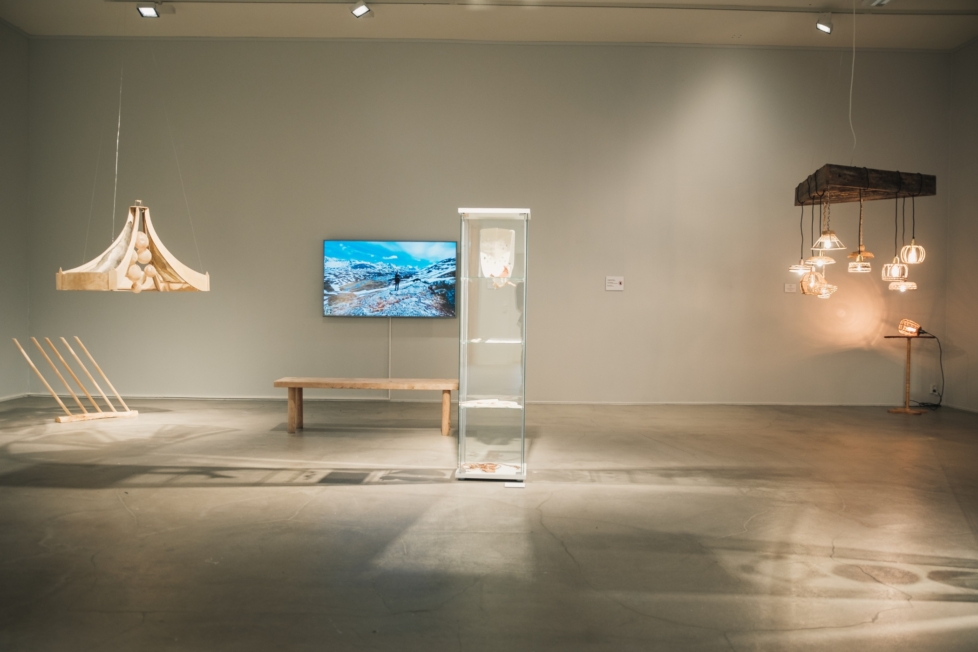
Nora Joung (with Maja Bekan, Emilie de Rohan Birkeland, Kaja Paulsen Breckan, Dora García, Ronak Moshtaghi, and Stacey de Voe), Governmental Operations, Stormen Kunst/ Dájdda, Bodø/Bådåddjå
The history of gender-based violence is as old as the history of patriarchal societies, and false accusations of witchcraft have been and continue to be one of their primary tools of control and suppression. Governmental Operations by Nora Joung and curated by Stian Hansen, looks back at the period between fall 1662 and spring 1663 when dozens of women in Vardø were falsely accused of demonic activities, mass-incarcerated, and burnt at the stake. Working with text, voice, and paper-installations, Joung and her collaborators evocatively revealed how the media contributed to this dark chapter of Nordic history by opening the flood gates to conspiracy theories and societal hysteria. With the rising cases of witchcraft accusations against women today, especially in places in Africa and Asia experiencing extreme duress from political-mismanagement and climate urgency, the exhibition also provides a grim reminder that there is no better moment than a crisis to perpetuate the history of male-dominated violence.

Gjert Rognli, Queering Polar History, Polar Museum, Tromsø/Romsa
Can a fur anorak tell us about gay life lived in Tromsø in the 1940s, and can a walrus tusk shed light on gender transgressions observed in the field in Siberia? These are some of the questions raised by the exhibition Queering Polar History, curated by Silje Gaupseth and Marit Anne Hauan, which brought new readings of the museum collection with the interventions of Sámi artist Gjert Rognli. Sourcing personal stories with a great deal of humour, as in vintage film footage tenderly documenting cross-dressing during Arctic expeditions, the project offered a welcome complication of the normative stories of a white, male-dominated Arctic.

Berit Kristine Andersen Guvsám, Laila Susanna Kuhmunen, and Gunvor Guttorm, AIDA – Communication and the Basis of Life, Sámi Center for Contemporary Art/Sámi Dáiddaguovddáš, Karasjok/Kárášjohka
With the global art world increasingly advocating for decolonial practice, this exhibition goes two steps further: on the one hand, by not simply proposing decolonising the archive, but Sámifying it; and, on the other hand, through building an understanding of duodji that goes beyond the usual mistranslation as a “craft” and towards duodji as a body of knowledge with various dimensions – material, spiritual, and ethical – that communicates with the world around us. Focusing on the personal archives of the three renowned duodjars Berit Kristine Andersen Guvsám, Laila Susanna Kuhmunen, and Gunvor Guttorm, the exhibition empowers the stories embedded in each archive, and advocates for a model where the archive remains in the possession of the author, is alive, generous to other makers, and eludes the mummification that so often characterises Western museum archives.
Katya García-Antón is the director of Nordnorsk Kunstmuseum. She has worked at The Courtauld Institute of Art, Museo Nacional Reina Sofía Madrid, ICA London, IKON Birmingham, and Centre d’Art Contemporain Genève. García-Antón curated the Spanish Pavilion (2011) and the Nordic Pavilion (2015) at the Venice Biennale. As director of OCA (2015–2022) García-Antón generated practices and programs centering Indigenous perspectives, including the transformation of the Nordic Pavilion into the Sámi Pavilion at the Venice Biennale in 2022, for which she was co-curator. She was selected amongst the top 100 art world figures of 2022 in the German art magazine Monopol.
For this year’s contributions to Kunstkritikk’s Advent Calendar, see here.
